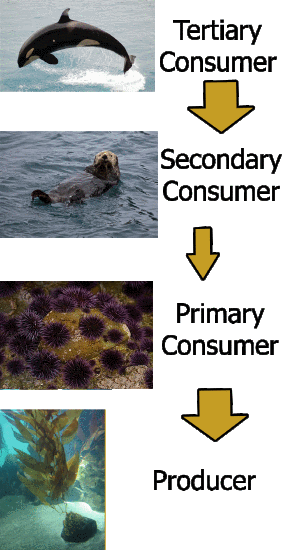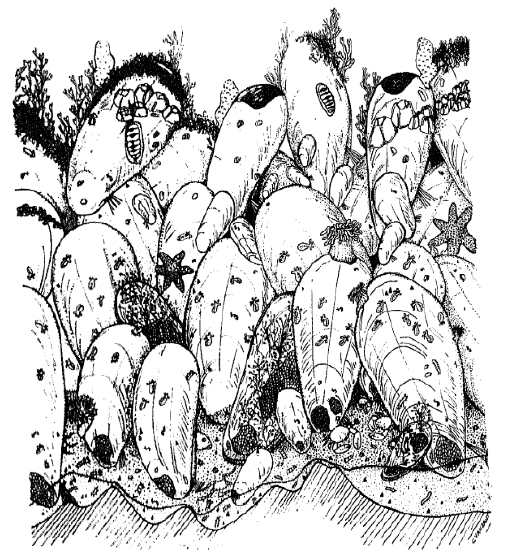59 8.7 Food Chains and Food Webs
Trophic Levels
A food chain follows one path of energy and materials between species. A food web is more complex and is a whole system of connected food chains. In a food web, organisms are placed into different trophic levels. Trophic levels include different categories of organisms such as producers, consumers, and decomposers. Producers are the basic trophic level while top predators are the peak level. Producers are autotrophs, meaning they produce their own food through photosynthesis or chemosynthesis. Consumers are animals that eat producers and are split into many different categories: primary consumers, secondary consumers, tertiary consumers, and more. Primary consumers are plant-eating herbivores; secondary consumers eat the herbivores; tertiary consumers can consume both the primary and secondary consumers. There may be more levels of consumers until eventually the top predator is reached. The relationship between trophic levels (e.g. primary producers, herbivores, primary predators, and top predators) is shown in Figure 1. It is important to note that consumers can be carnivores, animals that eat other animals, and also omnivores, animals that consume many types of food. Decomposers are also part of the food web and include organisms that feed on all varieties of dead plants and animals which are responsible for returning nutrients to the environment.
Energy Transfer
The amount of energy that flows through the different trophic levels of a food web is usually displayed as a pyramid (see above). This pyramid shows much more information than just a diagram for the hierarchy between predator and prey. The amount of area in each trophic level displays the amount of energy present in the biomass. Producers clearly occupy the largest area on the pyramid, and therefore the largest amount of energy. Autotrophs convert solar and chemical energy into the biologically usable form, glucose. In the form of glucose, energy is able to be introduced into the food web system and which is then transferred through consumption. Since autotrophs are the source of energy into the food web it makes sense that they contain the highest quantity of energy within their biomass. Although the individual primary producer is relatively tiny in itself, the vast number of producers results in their combined biomass being the largest trophic group in the ocean. The combination of their vast biomass and retention of much of the energy they produce is what leads producers to occupy such a wide base of the energy pyramid. As you move up the trophic levels the amount of energy gained from consumption decreases by a factor of approximately 10 per level. This means that primary consumers only receive 10% of the energy from primary producers when consumed. The most shocking is that the apex predator in the example above represents the quaternary predator and therefore only receives .01% of the energy that was produced by the original primary producer. Energy, then, gets trapped in unusable forms (eg. fiber and bone) and is used in metabolizing material into useable forms, leading to an overall loss.
Food Webs vs. Food Chains
Food webs are more complex than food chains, yet equally as useful in understanding the processes of ecological communities. Some food webs may be more complex than others but the concepts are always constant. A food web shows the flow of nutrients between different types of organisms which can help us understand the energy transfer as described before. Food webs begin with autotrophs and continue with heterotrophs, but due to their codependence, changes in abundance of one kind of organism may affect the others. For example, if the amount of phytoplankton were to suddenly decline dramatically, so would the number of heterotrophs that depend on the phytoplankton as a food source (known as ‘bottom up’ control of food webs).
When you examine a food web, you can observe how all the food chains interact in one community. When observing a single food chain, you can see the path in which energy and nutrients get passed along through a specific community. Since a food chain is much more simplistic than a food web, it can be used to predict the response of an ecosystem due to changes in population of a single species. Trophic cascades are one way in which a food chain can be used to predict changes in an ecosystem. A trophic cascade occurs when one species has a change in population size, resulting in changes in populations of other species within the food chain. A classic example of a trophic cascade is the example describing the relationship between orcas, sea otters, sea urchins, and kelp forests along the coasts of Alaska. It was found that an increase in killer whale predation was drastically reducing sea otter populations. Without a strong sea otter presence, sea urchin predation was low resulting in increased herbivory on kelp forests. With urchins free from significant predation, entire kelp forests were consumed resulting in urchin barrens which ultimately shifted the entire dynamic of these ecosystems. The use of food webs to predict changes in ecosystems through trophic cascades is essential to understand the full effects of humans on the natural world. They can help us better understand the best response to these cascades such as the one described above.
Types of Webs
In the ecological community there are two types of food webs: connectance webs and interaction webs: They are used to track the energy that flows within a community. Connectance webs use arrows that show the consumption of one species by another. These arrows are all of equal weight so there is no additional information about the strength of consumption between species (Atkinson et al. 2014). Interaction webs also use arrows to show the consumption of one species by another, but these arrows are weighted according to the interaction strength in the community. If one species is seen to regularly consume another then it will have a wide and dark arrow showing their connection. If it is observed that a species rarely consumes another then the connecting arrow will be very slim if present at all (Berlow et al. 2004).

Figure 1: This figure revisits the idea of trophic cascades with an increase in orca populations causing an increase in urchin populations and a decrease in sea otter and kelp populations. This image also illustrates a foundation species and keystone species within the same food chain.
https://upload.wikimedia.org/Wikipedia/commons/e/e5/JumpingOrca.jpg
pixabay.com/static/uploads/p…76_960_720.jpg
https://c2.staticflickr.com/8/7439/16455860102_388988b419_b.jpg
https://upload.wikimedia.org/Wikipedia/commons/3/34/CAS_Macrocystis_4.JPG
Foundation Species and Keystone Species
There are also organisms in a food web that are known as keystone species and foundation species. Foundation species tend to be primary producers and play a large role in the community due to their ability to build or provide a structure that other organisms inhabit (eg. mussels and kelp forests). These foundation species include organisms that impact a community by creating physical changes in the environment. Keystone species can be located anywhere in the food web, and play a vital role in the maintenance of the community. These organisms exert major influence over a community’s structure by ecological roles or niches. Keystone species are defined as those that have a disproportionate impact on an ecosystem relative to their abundance. Sea otters do not have a very high biomass in a kelp forest but through predation of other species (such as sea urchins), they have a strong impact on the health and biomass of the kelp.

Figure 2: A cross-sectional diagram of Mytilus californianus mussel bed with the abundant community living within the matrix the mussels create. Aggregations of these foundational species can provide habitat for over 300 species of organisms.
Diagram modified from Schanek T.H. (1992)
References
-
Atkinson, A., S. Hill, M. Barange, E. Pakhomov, D. Raubenheimer, K. Schmidt, S. Simpson, and C. Reiss. 2014. Sardine cycles, krill declines, and locust plagues: revisiting ‘wasp-waist’ food webs. Trends in Ecology & Evolution 29: 309-316.
-
Berlow, E., A. Neutel, J. Cohen, P. de Ruiter, B. Ebenman, M. Emmerson, J. Fox, V. Jansen, J. Iwan Jones, G. Kokkoris, D. Logofet, A. McKane, J. Montoya, and O. Petchey. 2004. Interaction strengths in food webs: issues and opportunities. Journal of Animal Ecology 73: 585-598.
-
Estes, J. A., Tinker, M. T., Williams, T. M., & Doak, D. F. (1998). Killer whale predation on sea otters linking oceanic and nearshore ecosystems. Science, 282(5388), 473–476. https://doi.org/10.1126/science.282.5388.473
-
Suchanek, T.H.(1992). Extreme Biodiversity in the Marine Environment: Mussel Bed Communities of Mytilus californianus. Northwest Environmental Journal, 8:1
By Hill et al. (University of California, Davis), used under a CC-BY-NC-SA 4.0 international license. Download this book for free at https://geo.libretexts.org/Bookshelves/Oceanography/Book%3A_Oceanography_(Hill)

